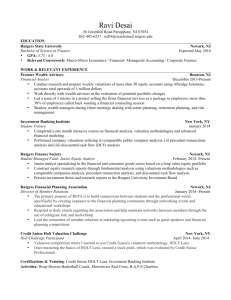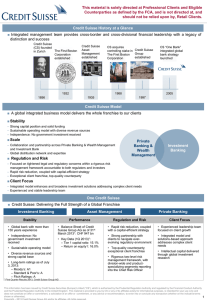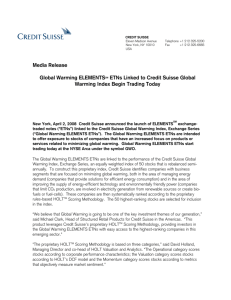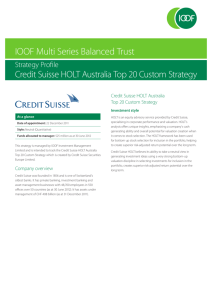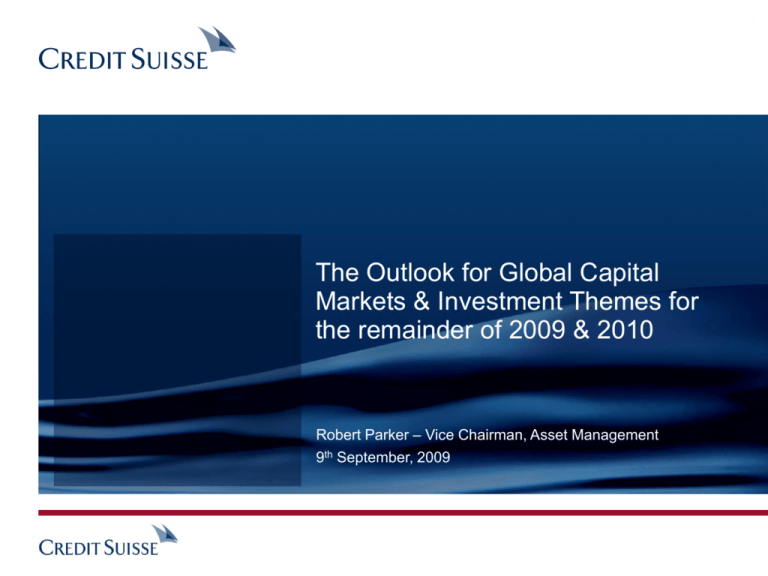
CONFIDENTIAL/ NOT FOR REDISTRIBUTION
The Outlook for Global Capital
Markets & Investment Themes for
the remainder of 2009 & 2010
Robert Parker – Vice Chairman, Asset Management
9th September, 2009
1
Key questions for global capital markets, investment
strategy and asset allocation
Assuming the credit crunch is over, how will credit conditions now evolve?
Is the economic recovery in the developed G20 countries durable and how will the
pattern of growth evolve?
Have emerging economies decoupled from the developed economies and will emerging
economies be the key driver in global growth?
Has the risk of deflation passed and what is the risk of a rapid return to inflation?
Will currency markets become unstable particularly with the major US fiscal deficit and
central bank reserve diversification leading to a US dollar sell-off?
Will emerging market demand lead to a further commodity boom?
After the significant decline in equity markets from mid-2007 to early 2009, have equities
now formed a base for a durable recovery and if so, which markets and sectors will
outperform?
What signs are there of recovery in alternative asset classes such as real estate, private
equity and hedge funds?
2
There are clear signs of recovery
Index
PMI New Orders
70
60
US
Japan
50
Eurozone
40
30
20
10
Jan-03
Oct-03
Jul-04
Apr-05
Source: PMI Premium, Bloomberg, Credit Suisse
Jan-06
Oct-06
Jul-07
Apr-08
Jan-09
Last data point: June 2009
3
Recovery has been pronounced in Asia
Index
70
PMI New Orders
65
India
60
China
55
50
Russia
45
Brazil
40
35
30
25
Jan-03 Oct-03
Jul-04
Apr-05 Jan-06 Oct-06
Source: PMI Premium, Bloomberg, Credit Suisse
Jul-07
Apr-08 Jan-09
Last data point: June 2009
4
Recovery is reflected in global trade and commodity
indices
Price index 2000 = 100
900
Baltic Dry Index
Brent oil
Copper
800
700
600
500
400
300
200
100
0
01/2000 01/2001 01/2002 01/2003 01/2004 01/2005 01/2006 01/2007 01/2008 01/2009
Source: IDC, Bloomberg
5
One source of the economic crisis, i.e. the US housing
market is now forming a base
US home inventories (new +existing homes)
NAHB Index versus US housing starts (yoy, %)
80
units on sale
2'500
70
4'500
2'000
60
4'000
50
3'500
40
3'000
30
1'500
1'000
20
2'500
500
10
2'000
0
1'500
Jun 93
Jan 89
Jan 93
Jan 97
Jan 01
Jan 05
Jan 09
0
Jun 97
Jun 01
US NAHB Housing Index
Jun 05
Jun 09
US Housing starts (rhs)
US existing + new homes inventory
House price to wage ratio
4.2
4.0
NAHB sentiment index leads housing starts by 2 months
3.8
3.6
3.4
Trough in NAHB
sentiment index
Jan 1991
Jan 1995
Oct 2001
3.2
3.0
2.8
2.6
Trough in housing
starts
Feb 1991
Apr 1995
Dec 2001
No months that
housing starts troughs
after NAHB trough
1
3
2
Jan 81 Jan 85 Jan 89 Jan 93 Jan 97 Jan 01 Jan 05 Jan 09
US existing house price/ median income
Pre-bubble average
6
Recovery has been boosted by public expenditure but
deficits are unsustainable
2000
2002
2004
2006
2008
2010
2012
0
-1
2014
110
105
Fiscal balance (lhs)
-2
100
-3
95
-4
90
-5
85
-6
80
-7
75
-8
Government debt (rhs)
70
-9
65
-10
60
%
Forecasts
%
Source: IMF, Credit Suisse
7
Credit conditions have improved but remain tight on trend
UK bank lending conditions
Euro-area bank lending standards
Private sector loan growth
20
10
13%
0
11%
ECB survey: net ch in expected lending standards, rhs, inv
-20
-10
0
-10
9%
10
-20
7%
20
-40
5%
30
-50
3%
-30
40
50
Tightening credit standards
-60
1%
Q2 07 Q3 07 Q4 07 Q1 08 Q2 08 Q3 08 Q4 08 Q1 09 Q2 09 Q3 09
Secured Lending-Credit To Households,Past 3M
-1%2003
Next 3 months
60
2004
2005
2006
2007
2008
2009
2010 70
US bank lending conditions
15
-20
-10
10
0
10
5
20
30
0
40
50
-5
-10
Total loans, y/y%
Banks tightening credit - average of firms, mortgages, credit
card, rhs, inverted, lead 12m
60
70
80
90 91 92 93 94 95 96 97 98 99 00 01 02 03 04 05 06 07 08 09
Source: Bank of England , © Datastream International Limited ALL RIGHTS RESERVED, Credit Suisse research
8
Demand for cash balances is elevated at banks....
18
Ratio: Excess Reserves to Required Reserves
16
14
12
10
8
6
4
9/11
Y2K
2
0
'99
'00
'01
'02
'03
'04
'05
'06
'07
'08
'09
Sources: Federal Reserve, Credit Suisse
9
Consumers are increasing savings
14%
US personal savings as % of disposable income, 3mma
12%
10%
8%
1959-87 avg: 9.1%
May 09
6%
4%
2%
0%
-2%
1959 1963 1967 1971 1975 1979 1983 1987 1991 1995 1999 2003 2007
Source: Bloomberg, Credit Suisse
Last data point: May 2009, Value: 6.9%
10
US consumer credit has collapsed
Source: Bloomberg, Credit Suisse
11
Emerging and developed economies are decoupling
Growth rate
Country group
& share of world
GDP (2008)
0%
1%
2%
3%
4%
5%
6%
7%
8%
Oil exporters*
(7.7% )
Contribution to
global growth
9%
Emerging G20**
(16.7% )
49%
Developed G20
(67.6% )
37%
2004
2004- –08E
08E
2009E - 14E
World***
Source: IMF, Credit Suisse
* Includes 22 oil-exporting nations
** Excludes Russia & Saudi Arabia
*** World includes G20 & oil-exporting nations Note: Real annual growth is estimated by multiplying
the real growth rate of each economy to its GDP share in the previous year (at market exchange
rates)
12
G3 countries; inflation has fallen sharply
12%
10%
G3 yoy% - Headline
8%
G3 yoy% - Core (ex food and energy)
6%
4%
2%
0%
-2%
Jan-81
Jan-83
Jan-85
Jan-87
Jan-89
Jan-91
Jan-93
Jan-95
Jan-97
Jan-99
Jan-01
Jan-03
Jan-05
Jan-07
Jan-09
Credit Suisse; the BLOOMBERG PROFESSIONAL™ service; DataStream
13
Global output gap with cyclical inflation
2
2.4%
0
2.0%
-2
1.6%
-4
-6
1.2%
-8
0.8%
-10
0.4%
-12
0.0%
-14
-0.4%
-16
-18
Output Gap w. Forecast (lhs)
-0.8%
G3+ Cyclical inflation (6m lag, rhs)
-20
-1.2%
Forecast
-22
Jan-97 Jan-98 Jan-99 Jan-00 Jan-01 Jan-02 Jan-03 Jan-04 Jan-05 Jan-06 Jan-07 Jan-08 Jan-09 Jan-10
-1.6%
Credit Suisse; the BLOOMBERG PROFESSIONAL™ service; DataStream
14
Taylor rule: forecasting official interest rates
10
9
Taylor Rule Policy Corridor
(based on Headline and Core Inflation Taylor Rules)
8
G3 LIBOR: 0.85%
(June '09 average)
Interest Rate
Futures
7
6
5
4
3
2
Dec '10:
1.23%
0.73%
1
0
-1
-2
-3
-4
Jan-85
Jan-87
Jan-89
Jan-91
Jan-93
Jan-95
Jan-97
Jan-99
Jan-01
Jan-03
Jan-05
Jan-07
Jan-09
Credit Suisse; the BLOOMBERG PROFESSIONAL™ service; DataStream
15
Capital market activity has improved
USD bn
2.0
US high yield debt issuance (8 week m.a.)
Average
1.5
1.0
0.5
0.0
2001
2002
2003
2004
2005
2006
2007
Source: Bloomberg, Credit Suisse
USD bn
20
15
2008
2009
Last data point: 26 June 2009
US equity issuance (4wma)
Average
10
5
0
1998 1999 2000 2001 2002 2003 2004 2005 2006 2007 2008 2009
Source: Trim Tabs, Bloomberg, Credit Suisse IB
Last data point: 25 June 2009
16
Credit markets have improved since late 2008
spread to benchmark
700
600
500
400
300
200
100
0
Jan 00
Jan 01
Jan 02
US financials
Source: Bloomberg, Credit Suisse / IDC
Jan 03
Jan 04
US industrials
Jan 05
Jan 06
Europe financials
Jan 07
Jan 08
Jan 09
Europe industrials
Last data point: 10.07.2009
17
Credit spreads emerging markets
spread to benchmark
2'500
2'000
1'500
1'000
500
0
Mar 02
Mar 03
Mar 04
Mar 05
Asia
Source: Bloomberg, Credit Suisse / IDC
Mar 06
Latin America
Mar 07
Mar 08
Mar 09
EMEA
Last data point: 30.06.2009
18
G3+ 10yr yield with kernel trend – yields remain
unusually low
8.0
7.0
6.0
5.0
4.0
3.0
Ja
n93
Ja
n94
Ja
n95
Ja
n96
Ja
n97
Ja
n98
Ja
n99
Ja
n00
Ja
n01
Ja
n02
Ja
n03
Ja
n04
Ja
n05
Ja
n06
Ja
n07
Ja
n08
Ja
n09
2.0
Credit Suisse; the BLOOMBERG PROFESSIONAL™ service; DataStream
19
USD trading above fair value
TWI Broad Index
140
120
100
80
29.06.2009
60
+1 Stdev
40
-1 Stdev
Fair value USD TWI "Broad"
20
0
Dec 82
Dec 86
Dec 90
Dec 94
Dec 98
Dec 02
Dec 06
Source: Bloomberg, Credit Suisse
20
USD: capital inflows into USA still very weak
External balance: the current account deficit has narrowed, but net capital inflows have also dramatically fallen
Source: Bloomberg, Credit Suisse / IDC
Last data point 31.05.2009
21
USD/JPY: Yen weakness is correlated with increased
investor risk taking
Source: Bloomberg, Credit Suisse / IDC
22
EM currencies: Brazil, China, India, Indonesia, Korea,
Mexico, South Africa, Turkey vs. USD
January 2008 = 100
150
Depreciation vs. USD
140
130
120
110
100
Appreciation vs. USD
90
01/ 2008 03/ 2008 05/ 2008 07/ 2008 09/ 2008 11/ 2008 01/ 2009 03/ 2009 05/ 2009
EM basket (Brazil, China, India, Indonesia, Korea, Mexico, South Africa and Turkey)
Source: Datastream, Credit
Suisse
23
Trade-weighted fair value measures
50%
40%
expensive
30%
20%
10%
0%
-10%
-20%
cheap
-30%
AUD
NZD
EUR
USD
CAD
HUF
NOK
ZAR
JPY
CHF
GBP
PLN
THB
SEK
SGD
TWD
KRW
CNY
-50%
MXN
-40%
Source: Bloomberg, Credit Suisse
24
Historic equity recoveries
(indexed to 100 at beginning of recovery, trough 1-2 Std Dev below trend)
180
February 1866
March 1938
December 1974
Average
June 1877
June 1949
February 2009
160
140
120
100
1
2
3
4
5
6
7
8
9 10 11 12 13 14 15 16 17 18 19 20 21 22 23 24
Credit Suisse; the BLOOMBERG PROFESSIONAL™ service; DataStream
25
Equity downside is protected by the credit rally
Over the past year, credit and equities have moved together
300
1,400
500
1,300
700
1,200
900
1,100
1,000
1,100
900
1,300
800
1,500
S&P 500, lhs
700
1,700
CDX high y ield spread, rhs, inv erted
600
Jul-08
Sep-08
Nov -08
Jan-09
Mar-09
May -09
Jul-09
Credit (BBB corporates)
Trough
Peak
Jun-80
Aug-81
Dec-82
Oct-87
Oct-87
Apr-90
Dec-90
Aug-97
Oct-98
Jan-00
Oct-02
Feb-07
Mar-09
Average
Equities (S&P 500)
Trough
Peak
May-80
Nov-80
Aug-82
Aug-87
Dec-87
Jul-90
Oct-90
Jul-98
Aug-98
Apr-00
Oct-02
Jul-07
Mar-09
Equity leads... (months)
Trough
Peak
1
9
4
2
-1
-3
2
-11
2
-2
0
-5
0
1
-2
Source: © Datastream International Limited ALL RIGHTS RESERVED, Credit Suisse
research
26
Investors are still long cash underpinning markets
US money market funds reached a record 49% of market
cap in early March (currently 36%)
US households, equities as % of all financial assets
35%
in %
35
US households, direct equities
as % of all financial assets
30%
30
25%
25
20
20%
15
10
15%
5
10%
0
Jun 83 Jun 87 Jun 91 Jun 95 Jun 99 Jun 03 Jun 07
Retail Money Market mutual funds/ US Eq. Market cap
Inst. Money Market mutual funds/ US Eq. Market cap
5%
Q1 Q1 Q1 Q1 Q1 Q1 Q1 Q1 Q1 Q1 Q1 Q1
1952 1957 1962 1967 1972 1977 1982 1987 1992 1997 2002 2007
Source: US Insurance team, © Datastream International Limited ALL RIGHTS RESERVED, Credit Suisse research
27
Earnings revisions
%
Net positive revisions as % of total
60
40
20
0
-20
-40
S&P500
-60
MSCI World
-80
1999
2000
Source: Datastream, Credit
Suisse
2001
2002
2003
2004
2005
2006
2007
2008
2009
Last data point: 1 July 2009
28
Corporate sector balance sheets have repaired themselves
US non-fin corporate FCF, % of GDP
5.0%
4.0%
US non-financial Corporate FCF/GDP
LT Average
US non-residential investment, % of GDP
20%
US Investment/GDP
US non-residential investment/GDP
18%
3.0%
2.0%
16%
1.0%
14%
0.0%
12%
-1.0%
-2.0%
10%
-3.0%
Q4 1969 Q4 1975 Q4 1981 Q4 1987 Q4 1993 Q4 1999 Q4 2005
8%
Q3 1959 Q3 1965 Q3 1971 Q3 1977 Q3 1983 Q3 1989 Q3 1995 Q3 2001 Q3 2007
US non-fin corporate financing gap
5.0%
4.0%
3.0%
2.0%
1.0%
0.0%
-1.0%
-2.0%
-3.0%
US corporate non-financial : Financing gap
(capex-int. generated funds) % GDP
Q4 Q4 Q4 Q4 Q4 Q4 Q4 Q4 Q4 Q4 Q4 Q4 Q4 Q4
1969 1972 1975 1978 1981 1984 1987 1990 1993 1996 1999 2002 2005 2008
29
Global equity risk premium (GERP)
%
12
10
8
6
4
2
0
-2
Jun 91
Jun 93
Jun 95
Jun 97
Earnings Yield Gap
Source: Datastream, Credit Suisse / IDC
Jun 99
Jun 01
Jun 03
Mean
+ / - 1 std. dev.
Jun 05
Jun 07
Jun 09
+ / - 2 std. dev.
Last data point: 13.07.2009
30
Valuations: equity valuations are in line with their longrun averages
1.6
US Tobin’s Q
1.5
1.4
US Tobin's Q ( EV at market/replacement v alue, nonfinancial business)
US market cap-to-GDP
Market cap / GDP
1.4
average
Non-farm, non-financial US corporates
1.3
1.2
1.2
1.1
1
1.0
0.8
0.9
0.8
0.6
0.7
0.6
0.4
0.5
Q3
Q2
Q1
Q4
Q3
Q2
Q1
Q4
Q3
Q2
Q1
Q4
1953 1958 1963 1967 1972 1977 1982 1986 1991 1996 2001 2005
0.2
1952 1957 1962 1967 1972 1977 1982 1987 1992 1997 2002 2007
US P/E on trend earnings
US 12-month forward P/E
24.0
22.0
20.0
18.0
16.0
14.0
12.0
US 12m Price/Earnings
10.0
1989 1991 1993 1995 1997 1999 2001 2003 2005 2007 2009
Source: © Datastream International Limited ALL RIGHTS RESERVED, Credit Suisse
research
31
Low-debt / higher beta sectors
Banks & Diversified Financials
0.8
R Estate
0.7
HOLT Total Book Debt/ Market Cap(FY0)
Pulp & Paper
0.6
Cons. Mats
Utilities
Transport
0.5
Insurance
Div. Tel.
Media
0.4
0.3
Cap. Goods
Food Retail
Food Products
Beverages
Tobacco
House. + Prsnl. Prod.
0.2
Comm Servs.
Wireless Tel.
Autos
Retail
HCare Equip
Energy
Metals & Mining
Tech Hard/ W
Biotech
0.1
Hotels
Chemicals
Cons Dur.
Semi's
Pharma
Software
0
0.5
0.7
0.9
1.1
1.3
1.5
1.7
Beta
Source: Datastream, HOLT, Credit Suisse
32
Emerging markets equities
Index (-10Y= 100)
350
300
MSCI World
MSCI Emerging Markets
250
200
150
100
50
Jul 99
Jul 00
Jul 01
Source: Bloomberg, Credit Suisse
Jul 02
Jul 03
Jul 04
Jul 05
Jul 06
Jul 07
Jul 08
Jul 09
Last data point: 2 July 2009
33
EM to World: P/E valuation relative
1.10
1.00
0.90
0.80
0.70
0.60
0.50
0.40
Jan 01
Jan 02
Jan 03
Jan 04
Jan 05
rel P/ E EM to World
Source: Datastream, Credit Suisse / IDC
Jan 06
Avg
Jan 07
Jan 08
Jan 09
+/ - 1 STD
Last data point: 06.07.2009
34
Capital market conclusions and investment strategy
The G3 countries have emerged from a steep recession but will experience at least 3
years of mediocre growth. The smaller European economies and central Europe will
emerge from recession last
Government action through expansionary monetary and fiscal policies has prevented a
sustained depression and a successful rescue of the banking industry has largely taken
place
Headline inflation has decelerated rapidly but long-term deflation should be avoided.
Inflationary expectations may deteriorate in 1H2010, but any upturn in inflation will prove
short-lived
The growth slowdown in the larger emerging markets has reversed quickly, although
emerging markets with current account deficits and over-leveraged banking systems will
remain under severe pressure in the medium term
On trend, Asia and Latin America are the most attractive emerging markets
After the strong performance of equity markets from early March until early August, the
1-2 months outlook is for an equity market correction. During the 4th quarter, equity
markets should outperform. In 2010 there is a risk that the equity market rally in
developed markets fails with markets going through a medium term period of broad
stability
35
Capital market conclusions and investment strategy
Foreign exchange market volatility has fallen. The Asian and Latin American currencies
are the most undervalued. The sterling devaluation is over
The investment grade credit rally is durable, although risk in the high yield market has
risen sharply. Risk/reward in Government bond markets is starting to erode
The banking system will be characterised by further de-leveraging. Banks with high
commission income and emerging market exposure will outperform those banks with
government ownership
Although real estate markets are undervalued, it is premature to forecast a recovery in
this sector. The central scenario is that real estate markets will move sideways for 2-3
years
Consumption will remain weak where consumers are de-leveraging, notably in the US
and the UK
On a 1-2 year view, defensive equity sectors in the G3 markets with strong cash flows
will out perform cyclical sectors. On trend, emerging markets will out perform developed
markets
Sectors that will benefit from the recession easing are IT and infrastructure
The nature of private equity is changing radically with 2009 being characterised by
significant valuation write-downs and sales of distressed assets. The improvement in the
hedge fund industry since the beginning of 2009 is likely to prove durable
36
Important Legal Information
This document was produced by and the opinions expressed are those of Credit Suisse as of the date of writing and are subject to change. It has been
prepared solely for information purposes and for the use of the recipient to whom it is distributed by Credit Suisse. No part of this document may be
reproduced or retransmitted in any matter without any prior written permission of Credit Suisse. It does not constitute an offer or an invitation by or on
behalf of Credit Suisse to any person to buy or sell any security. Nothing in this material constitutes investment, legal, accounting or tax advice, or a
representation that any investment or strategy is suitable or appropriate to your individual circumstances, or otherwise constitutes a personal
recommendation to you. The price and value of investments mentioned and any income that might accrue may fluctuate and may fall or rise. Any
reference to past performance is not a guide to the future. There are no guarantees concerning the achievement of investment objectives or target
returns or measurements such as alpha, tracking errors, stock weightings, and information ratios. The use of tools cannot guarantee performance.
The information and analysis contained in this publication have been compiled or arrived at from sources believed to be reliable but Credit Suisse does
not make any representation as to their accuracy or completeness and does not accept liability for any loss arising from the use hereof. A Credit Suisse
Group company may have acted upon the information and analysis contained in this publication before being made available to clients of Credit Suisse.
Credit Suisse does not represent, warrant or guarantee that this document is suitable for any investment purpose and it should not be used as a basis
for investment decisions.
Investments in emerging markets are speculative and considerably more volatile than investments in established markets. Some of the main risks are
political risks, economic risks, credit risks, currency risks and market risks. Investments in foreign currencies are subject to exchange rate fluctuations.
Before entering into any transaction, you should consider the suitability of the transaction to your particular circumstances and independently review
(with your professional advisers as necessary) the specific financial risks as well as legal, regulatory, credit, tax and accounting consequences. The
investment views and market opinions/ analysis expressed herein may not reflect those of Credit Suisse Group as a whole and different views are
expressed based on different investment styles, objectives, views or philosophies.
Copyright © 2009 Credit Suisse Group AG and/or its affiliates. All rights reserved.
37


